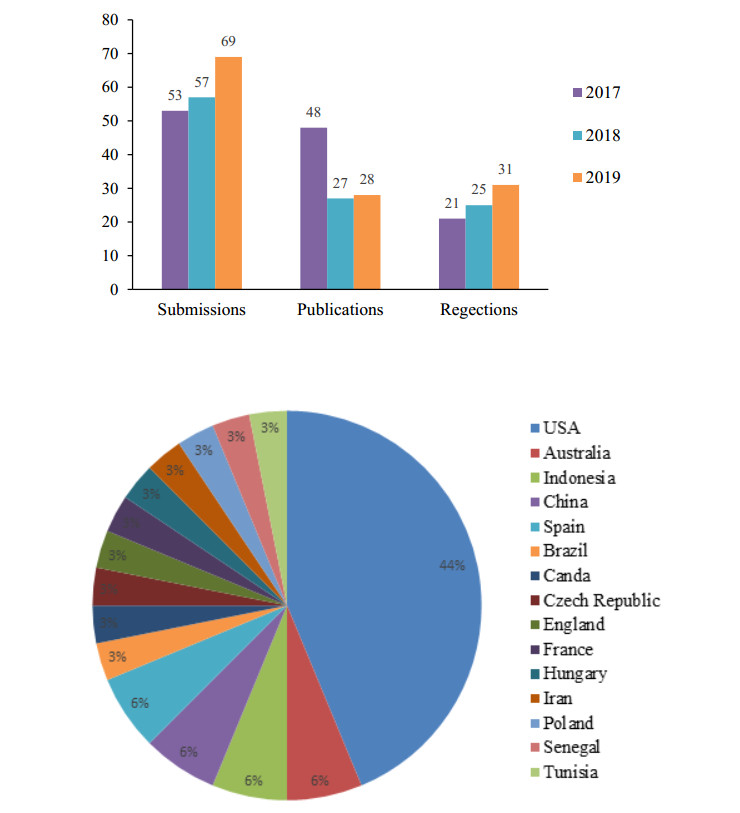In this paper, we investigate three particular algorithms: a stochastic simulation algorithm (SSA), and explicit and implicit tau-leaping algorithms. To compare these methods, we used them to analyze two infection models: a Vancomycin-resistant enterococcus (VRE) infection model at the population level, and a Human Immunodeficiency Virus (HIV) within host infection model. While the first has a low species count and few transitions, the second is more complex with a comparable number of species involved. The relative efficiency of each algorithm is determined based on computational time and degree of precision required. The numerical results suggest that all three algorithms have the similar computational efficiency for the simpler VRE model, and the SSA is the best choice due to its simplicity and accuracy. In addition, we have found that with the larger and more complex HIV model, implementation and modification of tau-Leaping methods are preferred.
Citation: H. Thomas Banks, Shuhua Hu, Michele Joyner, Anna Broido, Brandi Canter, Kaitlyn Gayvert, Kathryn Link. A comparison of computational efficiencies of stochastic algorithms in terms of two infection models[J]. Mathematical Biosciences and Engineering, 2012, 9(3): 487-526. doi: 10.3934/mbe.2012.9.487
Related Papers:
| [1] |
Yifeng Wang .
Journal summary from Editor in Chief. AIMS Environmental Science, 2024, 11(3): 380-380.
doi: 10.3934/environsci.2024018
|
| [2] |
Yifeng Wang .
Journal summary from Editor in Chief. AIMS Environmental Science, 2025, 12(2): 252-252.
doi: 10.3934/environsci.2025011
|
| [3] |
Yifeng Wang .
Journal summary from Editor in Chief. AIMS Environmental Science, 2021, 8(2): 100-100.
doi: 10.3934/environsci.2021007
|
| [4] |
Yifeng Wang .
Journal summary from Editor in Chief. AIMS Environmental Science, 2022, 9(2): 217-217.
doi: 10.3934/environsci.2022014
|
| [5] |
Yifeng Wang .
Journal summary from Editor in Chief. AIMS Environmental Science, 2023, 10(2): 245-245.
doi: 10.3934/environsci.2023014
|
| [6] |
Yifeng Wang .
Journal summary from Editor in Chief. AIMS Environmental Science, 2018, 5(1): 64-66.
doi: 10.3934/environsci.2018.1.64
|
| [7] |
Yifeng Wang .
Journal summary from Editor in Chief. AIMS Environmental Science, 2016, 3(1): 140-140.
doi: 10.3934/environsci.2016.1.140
|
| [8] |
Yifeng Wang .
Journal summary from Editor in Chief. AIMS Environmental Science, 2019, 6(4): 262-264.
doi: 10.3934/environsci.2019.4.262
|
| [9] |
Yifeng Wang .
Journal summary from Editor in Chief. AIMS Environmental Science, 2017, 4(2): 287-288.
doi: 10.3934/environsci.2017.2.287
|
| [10] |
Rukhsana Kokkadan, Resha Neznin, Praseeja Cheruparambath, Jerisa Cabilao, Salma Albouchi .
A Study of Infaunal Abundance, Diversity and Distribution in Chettuva Mangrove, Kerala, India. AIMS Environmental Science, 2023, 10(1): 82-92.
doi: 10.3934/environsci.2023005
|
Abstract
In this paper, we investigate three particular algorithms: a stochastic simulation algorithm (SSA), and explicit and implicit tau-leaping algorithms. To compare these methods, we used them to analyze two infection models: a Vancomycin-resistant enterococcus (VRE) infection model at the population level, and a Human Immunodeficiency Virus (HIV) within host infection model. While the first has a low species count and few transitions, the second is more complex with a comparable number of species involved. The relative efficiency of each algorithm is determined based on computational time and degree of precision required. The numerical results suggest that all three algorithms have the similar computational efficiency for the simpler VRE model, and the SSA is the best choice due to its simplicity and accuracy. In addition, we have found that with the larger and more complex HIV model, implementation and modification of tau-Leaping methods are preferred.
Dear Editorial Board Members,
It is my pleasure to share with you the year-end report for AIMS Environmental Science. The journal continues to improve its quality as indicated by steady increases in the number of manuscripts received and the number of articles published over the past three years (Figure 1). We have received 69 submissions with 28 published online. The most downloaded and cited papers are listed in Tables 1 and 2. The top read article received more than 11390 downloads.
I would like to thank all the board members for serving on the Editorial Board and their dedication and contribution to the journal, especially to the editors for two special issues: Impacts of Microplastics in the Urban Environment Conference and Green built environment. The goal in 2020 is to solicit more manuscripts and increase paper citations. We will try our best to reduce the processing time and supply with a better experience for publication. To recognize the contribution of the Editorial Board members and authors during the years, we will continue to offer that (1) for authors invited, the article processing charge (APC) is automatically waived; (2) each editorial board member is entitled for some waivers. I am looking forward to continuing working with you to make the AIMS Environmental Science a sustainable and impactful journal. Please don’t hesitate to send me e-mails if you have new ideas and suggestions to help us to achieve this goal.

Yifeng Wang, Ph.D.
Editor in Chief, AIMS Environmental Science










 DownLoad:
DownLoad:



